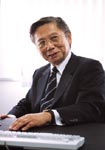The Macrovision of Masahiro Kawahata
Back to Contents of Issue: March 2001
|
|
|||
|
by Chiaki Kitada and Daniel Scuka |
|||
 Academic, inventor, technology guru, thinker, and business builder in both the US and Japan, Masahiro Kawahata embodies the Renaissance spirit many believe is required to build Japan's New Economy. Nominally engineering professor at Tokai University, he also holds positions at Stanford University and the Universities of Washington (UW) and Southern California. In the 1980s, he advocated a nationwide Cyber Japan plan based on optical fiber; a plan not unlike the Mori government's recently announced IT initiative. Later, he developed the technology behind one of the world's first and largest cable networks, eventually adopted by Tokyu Cable and other operators to power their cable TV businesses. He has worked at IBM (US) and Fujitsu. In the early 1990s, he participated in a study group at Southern California University focusing on the impact of information technology both in Japan and the US and drafted a scenario for fostering technology transfer across the Pacific. In 1993, he helped develop cutting-edge retinal scanning display technology with his colleagues at UW and established Microvision Inc. (Nasdaq: MVIS). Kawahata has received awards from MITI and other institutions. His current projects include scouting Japanese partners for Microvision and helping several other US ventures expand into this country, and he continues to help small and medium size companies learn from his experience. His passion is to bridge academia and industry, and promote technology transfer between universities and industry, and between nations. Chiaki Kitada and Daniel Scuka met with Kawahata at his Tokyo offices. A partial transcript follows. Academic, inventor, technology guru, thinker, and business builder in both the US and Japan, Masahiro Kawahata embodies the Renaissance spirit many believe is required to build Japan's New Economy. Nominally engineering professor at Tokai University, he also holds positions at Stanford University and the Universities of Washington (UW) and Southern California. In the 1980s, he advocated a nationwide Cyber Japan plan based on optical fiber; a plan not unlike the Mori government's recently announced IT initiative. Later, he developed the technology behind one of the world's first and largest cable networks, eventually adopted by Tokyu Cable and other operators to power their cable TV businesses. He has worked at IBM (US) and Fujitsu. In the early 1990s, he participated in a study group at Southern California University focusing on the impact of information technology both in Japan and the US and drafted a scenario for fostering technology transfer across the Pacific. In 1993, he helped develop cutting-edge retinal scanning display technology with his colleagues at UW and established Microvision Inc. (Nasdaq: MVIS). Kawahata has received awards from MITI and other institutions. His current projects include scouting Japanese partners for Microvision and helping several other US ventures expand into this country, and he continues to help small and medium size companies learn from his experience. His passion is to bridge academia and industry, and promote technology transfer between universities and industry, and between nations. Chiaki Kitada and Daniel Scuka met with Kawahata at his Tokyo offices. A partial transcript follows.
What started your interest in engineering and technology? I always wanted to work in an interdisciplinary area between business and academia, which I did both in Japan on the CATV development project and in the US with Microvision. When I work for universities, I'm always conscious about business, and vice versa. However, in Japan, there's no equivalent industry-academia bridging as there is in the US, so [here] I've been extremely frustrated. How did you first get involved with US venture business? Later, some VCs suggested forming a company to commercialize the idea. They were very happy to provide equity financing, and the university would license the rights to the new venture. The licensing fee was about $5 million; now I think that was a little too cheap. [Laughs.] The money was paid to the university, so they were very happy. At this time, 10 years ago, licensing like this would never happen in Japan -- this was before the TLOs [Editor's note: "technology licensing offices" are helping bring ideas developed in Japan's universities into the commercial realm], so I was very excited to get involved and work together with people who were trying to make the company grow. UW provided graduate students and research assistants to help develop the technology; some of them later moved to the new company, Microvision. It went public on Nasdaq in 1996. I am an advisory board member of Microvision and continue serving as a bridge between the company and UW. Interestingly, if you're kind of successful at making a public company, you start receiving many proposals from various parties. I was asked by quite a few investors, entrepreneurs, and other academics to work together on new commercial projects. Have you accepted any offers? With Microvision's retinal scanning display (RSD) technology, we understand you first looked for investment from Japan, but had no success. Now you're back. Why the change? I've come back to Japan because Microvision has been very successful at developing military and medical applications and other professional uses. Also, RSD has been sold to companies like Boeing for pilot training. Microvision is sure that the technology is very stable and practical and does not affect the eyes. Now, it's trying to make very small integrated circuits; there's a possibility of making the circuits cheaply, which would allow RSD to be incorporated into a small cellphone or a PDA.
The mechanism for assessing investments here is very different from the way it's done in the States. Here, there are few people who can evaluate the market potential and "investability" of new technology, even if the ideas are good. VCs don't want to make investments based solely on a business plan; they only listen to entrepreneurs after they start making money. You can't incubate venture businesses in this kind of environment. It's a Japanese mindset; there's no room for losers to recover from [a failed venture]. That's why people are afraid of taking risks and don't accept challenges. Therefore nothing happens. This is a very conservative society. For example, if you graduate from Tokyo University, you receive a full score [from society]. Your life is thereafter measured against how many points you lose by the time you retire from your job. Why come to Japan for partners now? How can Japan boost the transfer of research technology to industry?
What do you think of the TLOs in Japan? Under the TLO system, you cannot get away from government control if you accept support from them. You have to submit full reports to the authorities and sometimes provide positions to retired government officials. I was turned off by these constraints. [Editor's note: In Japan, in a practice called amakudari, some bureaucrats actively canvass companies formerly under their supervision to provide cushy post-retirement jobs in return for favorable administrative oversight.] The good ideas that professors and researchers develop at universities should be freely commercialized through external funding. The TLO is supposed to play a role as a booster to make this happen. Are Japanese academics actively working to commercialize their research? It's a lot easier to work together with American academics than Japanese, because there is a tradition in Japan -- and I'm not saying whether it's good or bad -- that a professor shouldn't make money. Here, if you make money, people look [down on] you, although this attitude is [starting to] change. At first, people looked at me and thought, "Raising money? He's not a real professor." But at recent university meetings, department and faculty heads have been saying, "What Professor Kawahata is doing is right." But there are still people who look at me as if I'm a different kind of being. I'm still feeling uneasy.
Is FTTH the best approach to getting broadband into Japanese homes?
Today, if you told students that Japan will lose its economic power [unless everyone works hard], they might say, "So what?" Today, the Japanese outlook has changed. People are rich; they're enjoying their lives. We have very nice restaurants. People have lost the hungry spirit. Of course people complain about low economic growth, but they are not seriously suffering from poverty. Five years ago, people were warning that Japan would go downhill, but it hasn't. People now can live with the fact that our country belongs to the upper middle or lower top class in the world, and they question whether we have to become No. 1 in the world, or even No. 2. They think, "It's fine, it's OK." Does the Japanese education system foster innovation? How can Japan maintain its position in the world? |
|||
Note: The function "email this page" is currently not supported for this page.




 What about fiber-to-the-home being promoted as part of the national IT initiative?
What about fiber-to-the-home being promoted as part of the national IT initiative? The CIA has reported that Japan's economic power and influence will decline by around 2015. What do you think?
The CIA has reported that Japan's economic power and influence will decline by around 2015. What do you think?


